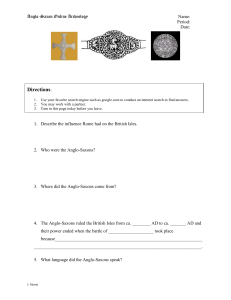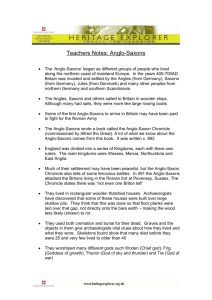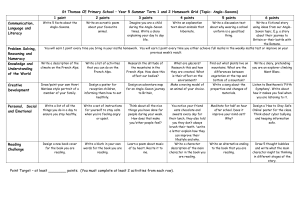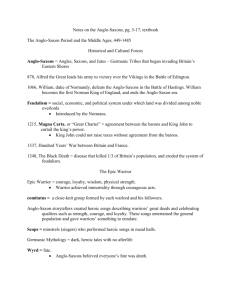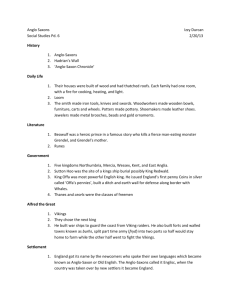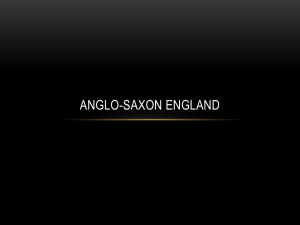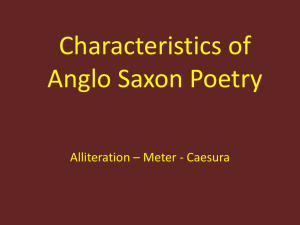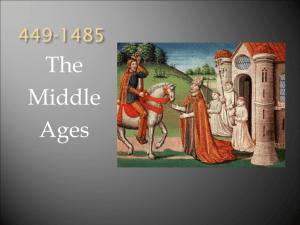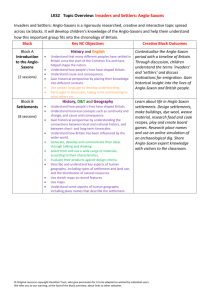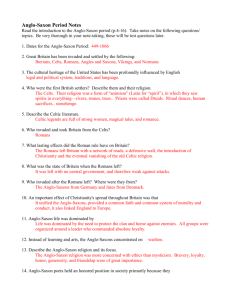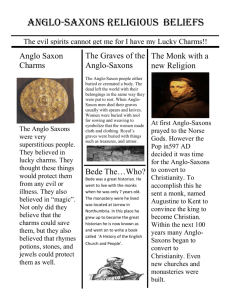Anglo-Saxons life
advertisement
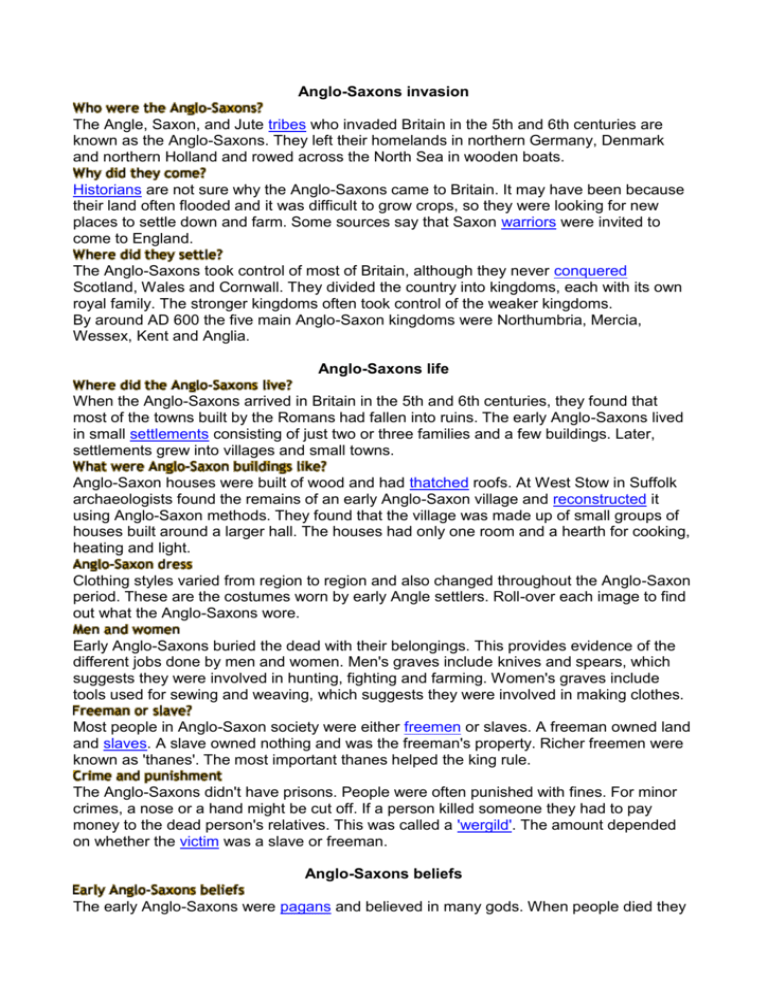
Anglo-Saxons invasion The Angle, Saxon, and Jute tribes who invaded Britain in the 5th and 6th centuries are known as the Anglo-Saxons. They left their homelands in northern Germany, Denmark and northern Holland and rowed across the North Sea in wooden boats. Historians are not sure why the Anglo-Saxons came to Britain. It may have been because their land often flooded and it was difficult to grow crops, so they were looking for new places to settle down and farm. Some sources say that Saxon warriors were invited to come to England. The Anglo-Saxons took control of most of Britain, although they never conquered Scotland, Wales and Cornwall. They divided the country into kingdoms, each with its own royal family. The stronger kingdoms often took control of the weaker kingdoms. By around AD 600 the five main Anglo-Saxon kingdoms were Northumbria, Mercia, Wessex, Kent and Anglia. Anglo-Saxons life When the Anglo-Saxons arrived in Britain in the 5th and 6th centuries, they found that most of the towns built by the Romans had fallen into ruins. The early Anglo-Saxons lived in small settlements consisting of just two or three families and a few buildings. Later, settlements grew into villages and small towns. Anglo-Saxon houses were built of wood and had thatched roofs. At West Stow in Suffolk archaeologists found the remains of an early Anglo-Saxon village and reconstructed it using Anglo-Saxon methods. They found that the village was made up of small groups of houses built around a larger hall. The houses had only one room and a hearth for cooking, heating and light. Clothing styles varied from region to region and also changed throughout the Anglo-Saxon period. These are the costumes worn by early Angle settlers. Roll-over each image to find out what the Anglo-Saxons wore. Early Anglo-Saxons buried the dead with their belongings. This provides evidence of the different jobs done by men and women. Men's graves include knives and spears, which suggests they were involved in hunting, fighting and farming. Women's graves include tools used for sewing and weaving, which suggests they were involved in making clothes. Most people in Anglo-Saxon society were either freemen or slaves. A freeman owned land and slaves. A slave owned nothing and was the freeman's property. Richer freemen were known as 'thanes'. The most important thanes helped the king rule. The Anglo-Saxons didn't have prisons. People were often punished with fines. For minor crimes, a nose or a hand might be cut off. If a person killed someone they had to pay money to the dead person's relatives. This was called a 'wergild'. The amount depended on whether the victim was a slave or freeman. Anglo-Saxons beliefs The early Anglo-Saxons were pagans and believed in many gods. When people died they were either cremated and put in a pottery urn or buried with their belongings. It was believed that the dead would need their belongings in their next life. In 1939, an amazing discovery was made at Sutton Hoo in Suffolk. When a large earth mound was dug up archaeologists found traces of an Anglo-Saxon ship and many precious objects. Archaeologists think this may have been the grave of King Redwald, who died around 625. After the Romans left, Christianity continued in the areas of England where Anglo-Saxons did not settle. In 597 the Pope sent a monk called Augustine to England to persuade the Anglo-Saxon kings to become Christians. Over the next two centuries, many Saxons turned to Christianity and hundreds of churches and monasteries were built. The monasteries were centres of learning, where monks and nuns devoted themselves to studying the Bible. The only children that went to school in Anglo-Saxon times where those that lived in monasteries. Years were spent in prayer, copying out manuscripts and writing books. Anglo-Saxons pastimes Feasts were held in the lord's hall. During the winter months everyone who was loyal to the lord would gather around the fire for a feast. At a feast people would eat roast meats, bread and fruit and drink beer or mead, a drink made from honey. As they ate and drank, the Anglo-Saxons listened to songs and stories about brave warriors and their adventures. One of the Anglo-Saxons' favourite stories was about Beowulf, a heroic prince who killed several monsters. Beowulf was first written down in the 8th to 9th centuries, many years after it was first told. Music was played to accompany the songs and poems. The most popular instrument was the lyre. The Anglo-Saxons liked to play with words and amused themselves by telling riddles, some of which were written down. See if you can solve the riddle below. Early Anglo-Saxons wrote using letters called runes. They believed runes had magical powers. What happened to the Anglo-Saxons? In the 8th and 9th centuries the people of Scandinavia, who were known as the Vikings, began to come to Britain. Anglo-Saxon accounts describe terrible Viking raids in which people were massacred, churches destroyed, and animals and precious objects stolen. By the end of the 870s, the Vikings occupied most of eastern England. Their territory was called the Danelaw. By 878 the Vikings had conquered all of England except Wessex. Wessex remained Anglo-Saxon as King Alfred of Wessex defeated the Vikings in battle. Gradually, the areas of England under Viking rule were reconquered by Alfred's descendants. The Anglo-Saxon period came to an end in 1066 when Duke William of Normandy came to England and defeated Harold, the Earl of Wessex, in the Battle of Hastings. This was the beginning of the Norman period in English history. The six centuries of Anglo-Saxon rule have had a lasting influence on England. Many places are still called by their Anglo-Saxon names, and many Anglo-Saxon words are still used today. Our system of law is also based on ideas that can be traced back to AngloSaxon times. Words used today faether - father sunu - son dohtor - daughter chese - cheese Anglo-Saxon place-names ford - river crossing ham - settlement den - hill ton - farm or village wic – farmstead
